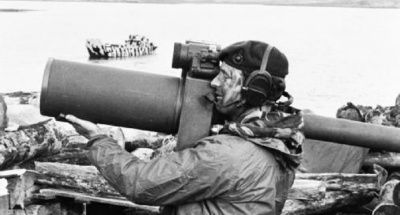| If you have been locked out of your account you can request a password reset here. |
Shorts Blowpipe
The Shorts Blowpipe was a British MANPADS launcher developed by Short Brothers PLC in response to a Ministry of Defence operational requirement in 1966, with the design entering service in 1975.
The system's odd appearance with two different barrel diameters is because, rather than use pop-out fins like most MANPADS launchers, the Blowpipe has fixed fins. To avoid having soldiers carry a launcher over four feet long and almost eleven inches in diameter, the tail assembly is detached and stored in the forward part of the tube, with the missile's fuselage going through it and into the slimmer rear tube: during launch, the missile slides out through the tail assembly, which is then fixed in place by a heat-sensitive glue. The missile uses a soft-launch system with a two-stage rocket motor, the sustainer motor accelerating it to Mach 1.5.
Blowpipe uses an exceptionally strange wireless radio command guidance system. The missile starts out in a SACLOS guidance mode with the launcher using the integral IR scope to track a thermal beacon on the missile's tail and automatically guiding it to the sight's crosshair (in a similar manner to systems like BGM-71 TOW), but 2-3 seconds after launch this is switched to MCLOS guidance, with the operator steering the missile directly using a small thumbstick: four flares on the missile's tail with sequential igniters assist the operator in visually tracking the missile. While this system had a theoretical advantage over period IR-guided tail-chasing missiles (FIM-43 Redeye, SA-7 Grail) in that it could be fired at an aircraft while it was still approaching, like all MCLOS missiles not featuring TV guidance, it was difficult to use against a moving target since the operator had to keep track of both the missile and the target at the same time: this task was difficult enough for ATGM systems, nevermind a SAM system. The missile has a range of 0.3 to 2.17 miles: on reaching maximum range, or if radio contact with the launcher is lost, the missile will self-destruct. As is normal for such systems, the missiles are provided in disposable launch tubes, which the reusable 13.7 lbs (6.2 kg) sight unit is attached to prior to firing. Missiles were transported in the field packed in a high-impact plastic protective case nicknamed the "wine bottle" due to its conical "neck," with integral shoulder straps to be worn on the soldier's back.
One very unusual application was the Submarine Launched Airflight Missile (SLAM), a cluster of six launch tubes in a retractable mounting designed to be installed in a submarine's conning tower to defend it while surfaced: this system was trialled on the Amphion-class submarine HMS Aeneas and despite the Royal Navy immediately realising it was a really bad idea, somehow made its way onto the three Israeli Gal-class submarines.
Blowpipe proved to be unreliable and extremely ineffective in the Falklands War, where it was used by both sides: in spite of over a hundred Blowpipe launches (the British alone firing 95), postwar studies could only credit two kills to the system, one British Harrier and one Argentine helicopter. Royal Marine Brigadier Julian Thompson described using it as like "trying to shoot pheasants with a drainpipe." Blowpipes would later be supplied to the Mujahideen in Afghanistan to similarly little effect.
The system was replaced with a derivative, the fully SACLOS Shorts Javelin launcher (not in any way related to the later American system) in 1985, which was itself later replaced by the laser-guided Javelin S-15 (known as Starburst in British service) in 1993 prior to the adoption of the Starstreak HVM in 1997. Production of Blowpipe missiles for a handful of export customers trundled on until 1993 with a total production run of 34,382 launch tubes. Antique Blowpipe launchers were pulled out of storage by the Canadian Navy during the 1991 Gulf War, though 9 of the 27 test-firings resulted in malfunctions, and Ecuador apparently became the only power to actually find Blowpipe useful during the 1995 Cenepa War, where they were mostly used against Peruvian helicopters.
The British Army maintains a stock of 285 Blowpipe launchers, though it is unlikely that they could explain why.
Specifications
(In service 1975-1985, production ended 1993)
Type: MANPADS, Surface-to-air missile (SLAM)
Caliber: Front tube 274mm (10.8in), rear tube 76mm (3in), 4.9 lbs (2.2 kg) impact or proximity fuzed HE fragmentation or HE-DP hollow charge warhead
Capacity: 1 missile in disposable launch tube (MANPADS), 6 missiles in disposable launch tubes (SLAM)
System weight: 48.5 lbs (22 kg)
Missile weight: 24.3 lbs (11 kg), 32 lbs (14.5 kg) including launch tube
Length: 53 in (1.35 m)
Fire Modes: Single shot, initial SACLOS "autogathering" for 2-3 seconds followed by MCLOS using thumb joystick
The Shorts Blowpipe SAM system appears in the following:
Video Games
| Game Title | Appears as | Mods | Notation | Release Date |
|---|---|---|---|---|
| Project Reality: Falklands | Blowpipe | Added around 2014, incorrectly shown as SACLOS | 2012 |
